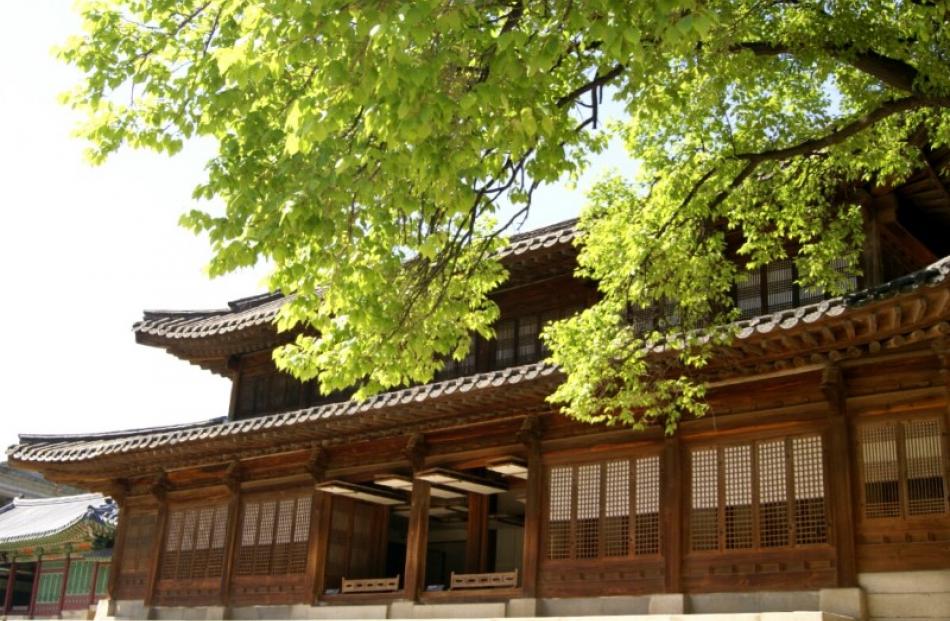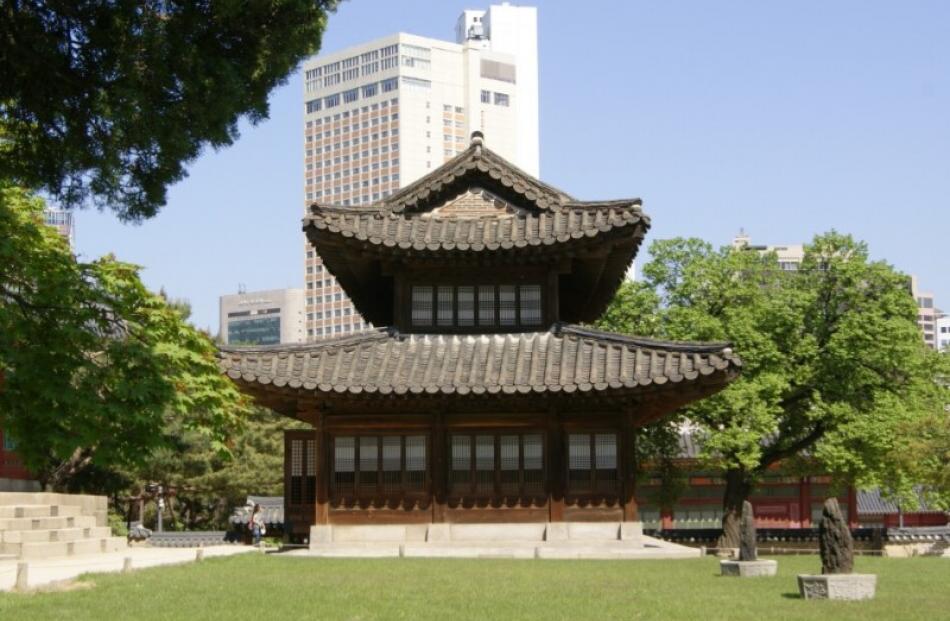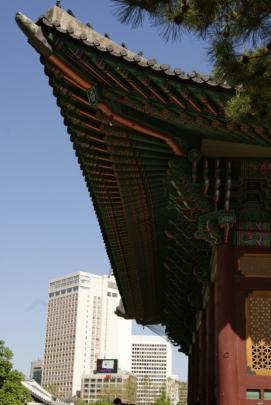In a city of 10.5 million people, it can be almost impossible to find space to sit and clear your head or walk without having to dodge people.
My solution: Deoksugung Palace, the Palace of Virtuous Longevity, also known as Gyeongun-gung.
While it is not the biggest, or apparently the most beautiful of Seoul's four main palaces, it is the only one open in the evenings. It is also only a short walk to the office where I work.
Nestled among the skyscrapers of Seoul's downtown business area and opposite the City Hall and Seoul Plaza (seemingly the only large-ish piece of grass in the city area), the palace does not look like much from the street. High brick walls, surprisingly clean for their age, line the footpaths, hiding the palace complex from everyday view.
The walls lead to Daehanmun, the entrance to the palace grounds. This gate was originally the east gate but became the main gate when the area to the east of the palace was developed and became the centre of Seoul. It was then known as Daeanmun, which means "be in great comfort" but was rebuilt in 1906 and renamed Daehanmun, meaning "Hanyang (Seoul's former name) will prosper".
This area is visible from the street and, when the palace is open, is always guarded by traditionally dressed men who perform an elaborate changing of the guard ceremony three times a day.
It involves teams of guards dressed in brightly coloured traditional dress (hanbok) with traditional weapons parading in front of Daeanmun and exchanging the key to the palace with the next shift.
Inside the gate, you walk across a small bridge, Geumcheongyo, which was excavated and restored in 1986.
From here, wide dirt paths lined with well-tended gardens lead you around the complex.
Much of the palace complex, just like the other palaces, was destroyed by the Japanese when they colonised Korea around the turn of the 20th century.
In recent years, many significant buildings that had been destroyed have been rebuilt. However, at Deoksugung, only about a third of the original buildings remain.
Due to the encroaching city, the palace grounds are much smaller than they once werem, also about a third.
There are 11 traditional buildings in the complex, mostly covered with the bright coloured and intricate patterned facades typical of ancient Asia.
The buildings are closed to visitors but you can look through the slat windows to see the simple furnishings.
In the centre of it all is the magnificent (I hate that this word is so overused but in this case, it is apt) Junghwajeon, the main hall of the palace and where the kings sat on their thrones, welcomed foreign envoys and where their successors were crowned.
Originally it had a two-tiered roof but now has only a single-tiered one due to financial constraints when it was rebuilt in 1906 after being burnt down two years earlier.
The doors to this hall are open, though there is a barrier to stop you entering, you can see the elaborate interior. At least you could, if you have the patience to wait in line - only three or four people can comfortably stand at this entrance at one time.
But it is not just traditional Korean architecture to be found at this palace - western style and fusion buildings can also be seen.
Two large western-style buildings were built within the palace grounds, apparently as part of the Great Han Empire's (1897-1910) rush to modernize.
One of them, Seokjojeon, was built in 1910 at the behest of J. M. Brown, a Brit who served as a financial advisor to the empire.
It was also partly designed by a Brit, G. R. Harding, but was later taken over by a Japanese designer and construction company.
It is a three-storey neoclassical building with verandas on three sides.
When Emperor Gojang inhabited the palace, this building was used as his sleeping quarters and audience halls.
In 1938, a western style garden and fountain were added in front of Seokjojeon. Traditionally, Korean gardens are behind the buildings.
Later, another building, in similar style, was built next to this building. It now houses the National Museum of Art.
In all, Deoksugung was inhabited by various royal families for almost five centuries.
It was originally the residence of Prince Wolsan, older brother of King Seongjong who reigned from 1469 to 1494.
It became an official royal palace when, in 1592 during the Japanese Invasion (the Imjin War), all other palaces were destroyed.
King Gwanghaegun was crowned in the palace in 1608 and then renamed it Gyeongun-gung in 1611.
In 1615 the official palace became Changdeokgung and Deoksugung was used as an extra palace for 270 years, known as Seogung or West Palace.
In 1897 Emperor Gojong (crowned as a king but assumed the title of emperor) moved to the palace and renamed it Gyeongungung. When he abdicated to Emperor Sunjong in 1907 he continued to live there (in Seokjojeon) and the new Emperor renamed it Deoksugung, in reference to Gojong's longevity.
Deoksuging served as the main palace of the short-lived Great Han Empire from 1897 to 1910.
After Gojong died in 1919, the Japanese sold much of the palace land and in 1933; most of the buildings were removed.
According to information at the palace, the complex's original form is nearly impossible to discern because it suffered so much alteration during the Japanese occupation.
Anyone wanting to visit the palace should take subway line one (dark blue) or two (green) to City Hall Station and use exit two or 12.
Entry is 1000 won (about NZ$1.10) for adults or 800 won for children.
It is open 9am to 9pm, Tuesdays to Sundays.
Free guided tours (in English) are run at 10.30am on weekdays or 1.40pm on weekends (on Saturdays in every second month starting from January and on Sundays every other month).





















